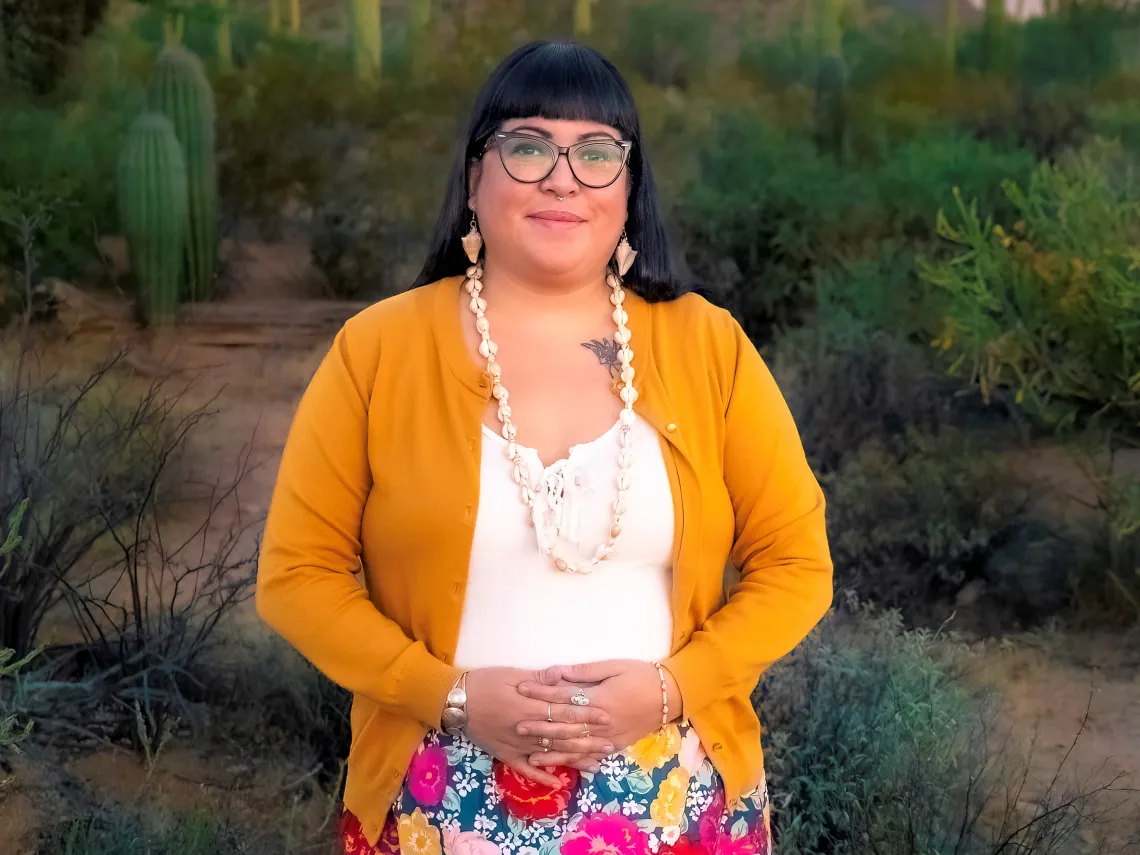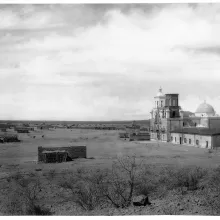Graduate Student Profile: Jacelle Ramon-Sauberan Chronicles Tohono O'odham History at San Xavier District

Jacelle Ramon-Sauberan. Photo by Leslie Ann Epperson.
"When it came to the news, the reporting was either negative about Indigenous people, or we were non-existent. I wanted to change that. So now, I am writing from firsthand experiences about the San Xavier District. I am writing about the history of land and water use." ~ Jacelle Ramon-Sauberan
Jacelle Ramon-Sauberan is finishing up a chronicle of Tohono O'odham history at San Xavier for her doctorate in American Indian Studies, with a minor in journalism at the University of Arizona. She is an enrolled member of the San Xavier District of the Tohono O'odham Nation, or TON.
Drive 20 miles south of Tucson, close to the winding Santa Cruz River, and there, high above the desert floor, gleam the white-washed dome and towers of the Mission Church of San Xavier del Bac. The church is a National Historic Landmark and a popular tourist attraction. But it sits on the much older Tohono O'odham homeland. In the late 1700s, Tohono O'odham laborers and artisans were fundamental to the construction and decoration of the edifice, even painting cactus shapes into the Catholic iconography in the nave.
"This area has been home to O'odham for time immemorial and is called Wa:k in the O'odham language," Ramon-Sauberan said. Wa:k means where the water goes in, referring to the aquifers in the Santa Cruz basin.
The Tohono O'odham applied ancient irrigation techniques to farm the desert long before the Spanish arrived, growing traditional Tohono O'odham crops, including corn, squash, and tepary beans, Ramon-Sauberan said.
"My great-great-grandfather was a farmer. He used the canal system built by our ancestors to bring water from the Santa Cruz River to our farm," Ramon-Sauberan said
Ramon-Sauberan always wanted to write. She began her career with a B.A. in journalism from the University of Arizona. She interned with The New York Times Student Journalism Institute and the American Indian Journalist Institute before serving as a reporter for Indian Country Today Media Network and the Osage News in Oklahoma. However, Ramon-Sauberan comes from a family of educators. At their urging, she returned to the University of Arizona for a master's degree in American Indian Studies.
Ramon-Sauberan combined her journalism skills with academic research to write her thesis in 2016, a 90-page biography about the late anthropologist Dr. Bernard "Bunny" Fontana. "His life's work was on San Xavier and the San Xavier Mission,” Ramon-Sauberan said. “I wanted to know more about who he was, the relationships he grew to have with so many of my relatives and the San Xavier Community and so forth. He wrote about O'odham, so I flipped the script and wrote about him."

Mission San Xavier del Bac, showing small Indian structures, Tucson, Arizona, ca.1898-1900
Now, Ramon-Sauberan is tracing the fissures caused by the colonial domination of her people and the gains made during the last 50 years. She has been gathering oral histories and documents with advice from her mother, Janice Ramon. “My mom is a scholar. She is a linguist; she can read, write and speak our language."
Ramon-Sauberan's aunt, Julie Ramon-Pierson, a long-time activist, has also been key to her research. Her aunt witnessed and fought for O'odham rights to water and land while carefully saving documents concerning the struggles. She told Ramon-Sauberan, "We need to have our history written down. Too many elders are passing away. They are taking their knowledge with them."
Ramon Sauberan explains, "San Xavier is the only parcel of the Tohono O'odham reservation where allotment happened. We are landowners here. The younger generation does not always understand the importance of being an allottee, a landowner."
The Tohono O'odham Nation once stretched from Central Arizona to Sonora, Mexico, and west to the Gulf of California. The U.S. drew the first Tohono O'odham reservation boundary around San Xavier in 1884. Following the passage of the Dawes Act of 1887, the U.S. government assigned so-called allotments of land to Indigenous people on reservations, hoping to assimilate them, Ramon Sauberan said. At the time, San Xavier was the only reservation established for the Tohono O'odham and, therefore, the only reservation to receive land allotments.
"The Dawes Act was directly responsible for the loss of 90 million acres of Indigenous land," says Ramon-Sauberan. The government assigned up to 160 acres to the head of a household after they registered with the government. The householder received citizenship and the land title if they farmed or ranched the land for 25 years. While seeming to benefit Indigenous people, the allotments significantly reduced the amount of Indigenous territory, Ramon-Sauberan said.
Teasing out this fracture and others that followed in the 20th century is a task requiring research into both oral and written history. However, this is personal for Ramon-Sauberan. "I am a future landowner." She proudly points out that Tohono O'odham landowners returned to their collective ways in 1971 by joining their allotments to form the now thriving San Xavier Co-op Farm. "It took time," says Ramon-Sauberan. "Now we sell commercial crops and share traditional crops with the community."
Although cooperative agreements paved the way for more useful cropland, development in Tucson and the surrounding region reduced the Santa Cruz River to an ephemeral stream. Ramon-Sauberan says she could have written an entire thesis about the District's fight to get rights to Colorado River water through the Central Arizona Project. After lengthy court battles, the Southern Arizona Indian Water Rights Settlement, or SAWRSA, was passed in 1982, although water did not become available for some 20 years. Ramon-Sauberan notes that her aim is to convey the often-heroic community action taken to return the District to farming and safeguard their rights.
Although the pandemic slowed Ramon-Sauberan's investigations and brought grief to her tightly-knit community, she persevered. She is now a mother and a faculty member teaching Tohono O'odham Studies Program at Tohono O'odham Community College, a tribal college near Sells, AZ. She is a communication specialist for NSF NOIRlab at Kitt Peak National Observatory. For the AZ Speaks series sponsored by AZ Humanities, Ramon-Sauberan presents the history and culture of the Tohono O'odham, a task that she relishes.
Ramon-Sauberan values cultural history and wants her dissertation to be a resource for O'odham youth and the community. After archiving 19 oral histories for her project, Ramon-Sauberan will donate these histories to the TON.
"It is a way of ensuring that we pass on the knowledge of the elders. It is for my daughter, my nieces, and future generations," she said.

